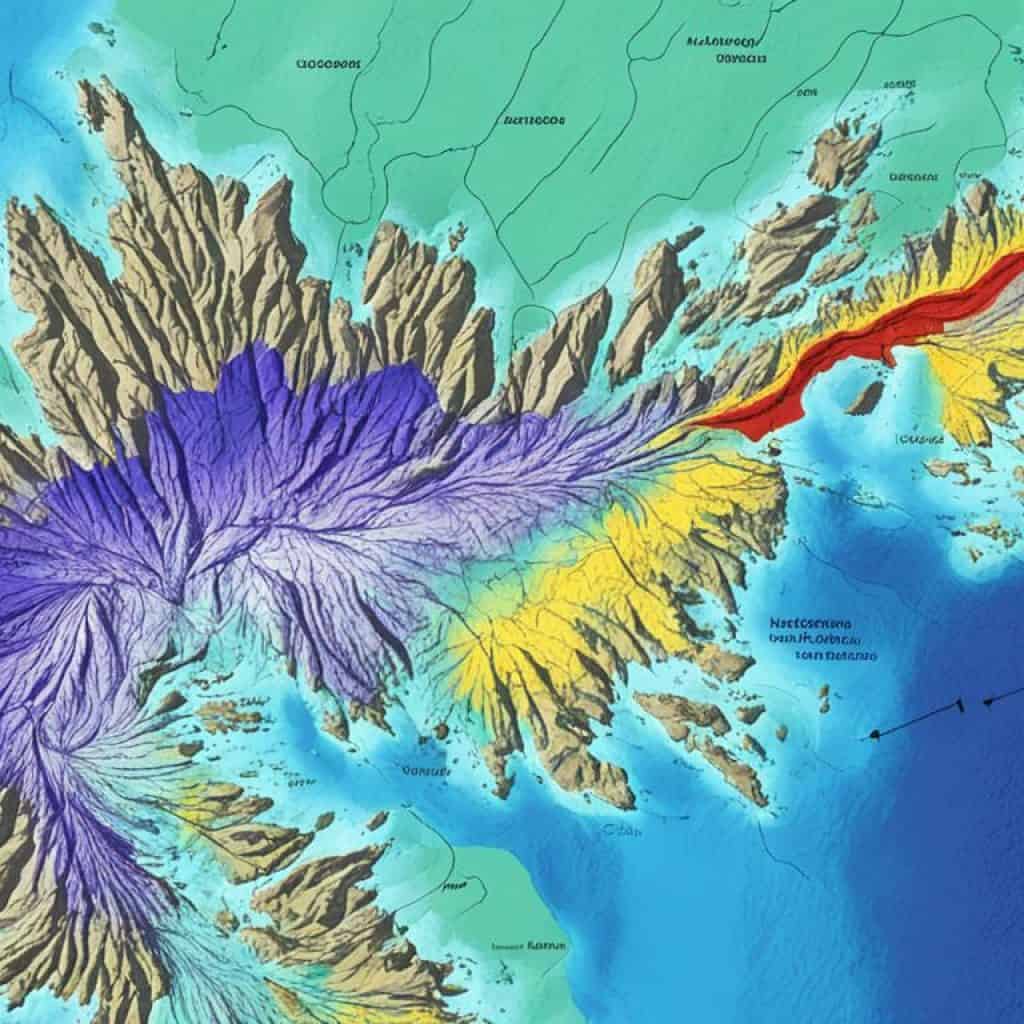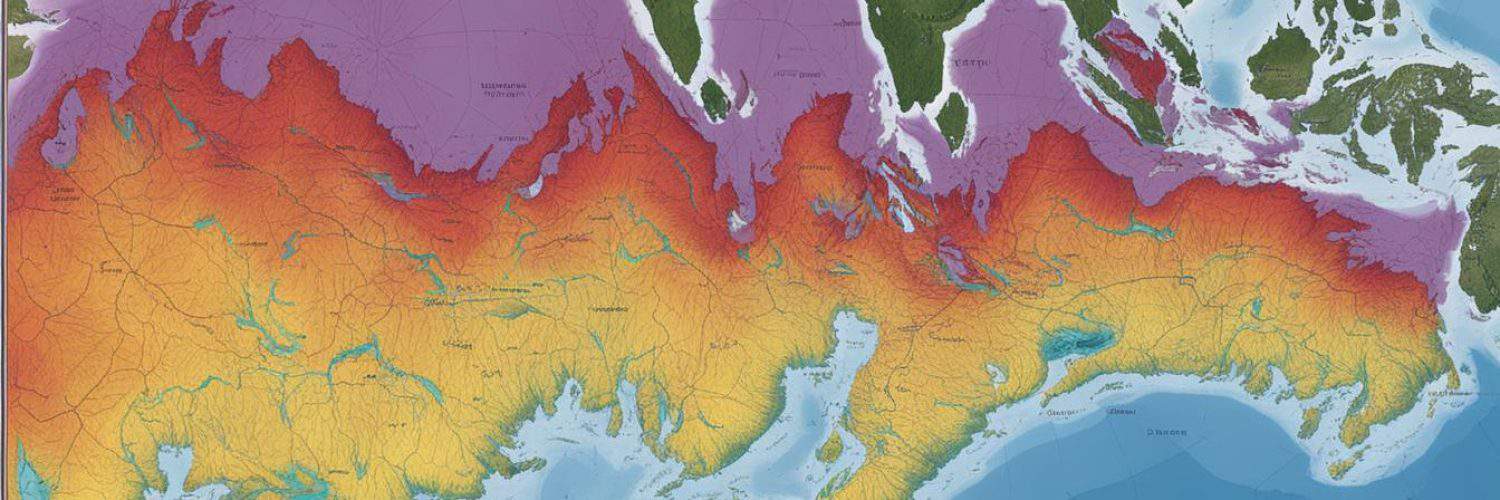Did you know that the Philippines is located in the Pacific Ocean’s Ring of Fire and is prone to frequent earthquakes? But have you ever wondered why this seismic activity is so prevalent in the country? What causes these earthquakes and where do the fault lines lie?
The Philippines is situated between the Philippine Plate, Eurasian Plate, and Indo-Australian Plate, resulting in the formation of the Philippine fault zone. This fault zone is a major inter-related system of geological faults throughout the entire Philippine archipelago, caused by tectonic forces compressing the Philippines into the Philippine Mobile Belt.
In this article, we will delve into the fascinating world of fault lines in the Philippines. We will explore the tectonic plates that surround the country, examine the formation and characteristics of the Philippine fault zone, and analyze the seismic hazards and risks associated with these fault lines. Whether you are living in the Philippines or just curious about the country’s geology, this article will provide valuable insights.
Key Takeaways:
- Fault lines in the Philippines are a result of tectonic forces compressing the country into the Philippine Mobile Belt.
- The Philippine fault zone is a major inter-related system of geological faults throughout the entire Philippine archipelago.
- The Philippines is located in the Pacific Ocean’s Ring of Fire, making it prone to frequent earthquakes and volcanic eruptions.
- Understanding fault lines is crucial for earthquake preparedness and safety in the Philippines.
- By utilizing resources like the PHIVOLCS Fault Finder, individuals and communities can mitigate the risks associated with earthquakes.
The Philippine Mobile Belt and Tectonic Plates
The Philippine Mobile Belt is a significant geological feature in the Philippines that is closely associated with the tectonic plates in the region. Composed of accretionary blocks and terranes, the Philippine Mobile Belt runs in a north-south direction, marked by fault lines.
The westward compression of the Philippine Mobile Belt is primarily influenced by the Eurasian Plate and the Sunda Plate, while the Philippine Sea Plate exerts pressure from the east. The interaction and movement of these tectonic plates have resulted in extensive faulting across the Philippines, predominantly on a north-south axis.
The faults in the Philippines are interconnected, forming the Philippine Fault System, as a consequence of the tectonic forces exerted by the Philippine Mobile Belt. This system encompasses a network of faults that contribute to the seismic activity in the region.
| Features | Description |
|---|---|
| Composition | The Philippine Mobile Belt is made up of accretionary blocks and terranes. |
| Direction | Runs in a north-south direction in the Philippines. |
| Compression | Compressed on the west by the Eurasian Plate and the Sunda Plate, and on the east by the Philippine Sea Plate. |
| Fault System | Interconnected faults form the Philippine Fault System, influenced by the tectonic forces of the Philippine Mobile Belt. |
The Philippine Fault Zone
The Philippine Fault Zone is a significant geological feature that stretches 1200 km across the entire Philippine archipelago. Situated behind the convergent boundary of the Philippine Trench and the subduction of the Philippine Sea Plate, this fault zone plays a crucial role in the tectonic activity of the region.
This fault zone is classified as a left-lateral strike-slip fault, accommodating the lateral oblique motion of the subducting Philippine Sea Plate in relation to the Philippine Trench. It passes through various regions, including Davao Gulf, Agusan River Basin, Leyte, Masbate, Quezon, Nueva Ecija, and Ilocos.
The slip rate of the Philippine Fault Zone is estimated to be approximately 2-2.5 cm/year, indicating the ongoing movement and potential for seismic activity in the affected areas.

The Philippine Fault Zone holds immense geological significance, contributing to the understanding of fault systems and seismic hazards in the Philippines. By studying and monitoring this fault zone, scientists and researchers can better assess the risks associated with earthquakes and develop strategies for disaster preparedness and mitigation.
Formation of the Fault Lines
The formation of the Philippine Fault Zone is believed to be the result of “shear partitioning,” a geological process driven by the oblique motion of subduction at the convergent zone. This motion has led to the development of the major strike-slip fault in the region. The oblique motion is accommodated by the Philippine Trench and the Philippine Fault Zone, with approximately 30% of the motion occurring along the fault.
The development of the fault lines occurred in two stages. The northern segments of the fault formed around 10 million years ago due to the convergence of the China Sea Crust. The central segments, on the other hand, developed between 2.7 and 3.8 million years ago.
Understanding the formation of these fault lines is crucial in assessing the seismic activity and risks associated with earthquakes in the Philippines.
Earthquakes Along the Fault Lines
The Philippine Fault Zone, including the Guinayangan, Masbate, and Central Leyte faults, is known for its seismically active nature. These faults are responsible for generating earthquakes in different magnitudes and frequencies across the region.
At the Guinayangan fault, large and destructive earthquakes occur approximately every 30 to 100 years. With slip rates ranging from 20 to 33 mm/year, this fault poses a significant seismic hazard.
The Masbate fault, on the other hand, experiences moderate earthquakes with frequent aftershocks. The ongoing displacement and slip rates of 5 to 35 mm/year indicate continued seismic activity in this area.
The Central Leyte fault exhibits varying seismic activity depending on the region. In the southern part, moderate earthquakes occur, while the northern part experiences creep at an estimated rate of approximately 25 mm/year.
Summary of Fault Characteristics and Seismic Activity
| Fault | Seismic Activity | Slip Rates (mm/year) |
|---|---|---|
| Guinayangan fault | Large and destructive earthquakes | 20-33 |
| Masbate fault | Moderate earthquakes with frequent aftershocks | 5-35 |
| Central Leyte fault | Moderate earthquakes (south) and creep (north) | Moderate events in the south and 25 creep in the north |
Understanding the seismic activity and slip rates of these fault lines is crucial for earthquake preparedness and risk mitigation in the affected areas. By staying informed and implementing appropriate safety measures, individuals and communities can enhance their resilience and minimize the impact of future earthquakes.
Other Active Fault Systems
Alongside the Philippine Fault Zone, the Philippines is home to several other active fault systems that contribute to the country’s seismic hazards. These fault systems have their own unique characteristics, locations, and potential risks. Let’s explore some of them:
Valley Fault System
The Valley Fault System is a significant fault line that runs through the provinces of Bulacan, Rizal, Laguna, and Cavite. With a length of around 90 kilometers, this fault system is divided into two segments – the West Valley Fault and the East Valley Fault. The Valley Fault System poses a substantial risk to densely populated areas in Metro Manila, making it crucial for residents to be prepared for potential earthquakes.
Macolod Corridor
The Macolod Corridor fault system is located in the province of Negros Oriental in the Visayas region. It is characterized by a series of northwest to southeast trending faults that cross the Macolod Corridor area. This fault system plays a significant role in the seismic activity of the region, highlighting the importance of assessing earthquake preparedness in the affected areas.
Lubang-Verde Passage Fault System
The Lubang-Verde Passage fault system is situated in the vicinity of Lubang Island and Verde Island Passage in the western part of Luzon. It is a complex fault system composed of several faults that have the potential to generate earthquakes. Understanding the characteristics and behavior of this fault system is essential for mitigating seismic risks in the region.
Mindoro/Aglubang Fault
The Mindoro/Aglubang Fault is a fault system that spans the island of Mindoro and nearby areas. It is an active fault characterized by significant horizontal displacement and creates potential seismic hazards for the island. The presence of this fault system underscores the importance of earthquake awareness and preparedness among Mindoro’s residents.
Sibuyan Sea Fault
The Sibuyan Sea Fault is located in the Sibuyan Sea in the central Philippines. It plays a role in the tectonic activity of the region and can potentially generate earthquakes. Being aware of this fault system and its associated risks is crucial for communities living near the Sibuyan Sea.
Legaspi Lineament and Tablas Lineament
The Legaspi Lineament and Tablas Lineament are two fault systems found in the Bicol region and the province of Romblon, respectively. These lineaments represent major fault zones in their respective areas, contributing to the seismic hazards faced by these regions. Understanding the characteristics and behavior of these fault systems is vital for assessing earthquake risks and implementing appropriate safety measures.
Mindanao Fault
The Mindanao Fault is one of the largest fault systems in the Philippines and is situated in the southern part of the country, primarily within the island of Mindanao. This fault system is associated with significant seismic activity and has the potential to generate strong earthquakes. Residents in Mindanao need to be aware of the risks and prepare accordingly for earthquake events.
Offshore Cebu-Bohol Faults
The Offshore Cebu-Bohol Faults are located in the waters surrounding Cebu and Bohol islands. These fault systems are associated with active tectonic activity and have the potential to generate underwater earthquakes. While the immediate coastal areas may not be directly impacted, the seismic activity can indirectly affect nearby communities. Being aware of these fault systems is essential, especially for those residing in coastal regions.
Understanding the presence of these various active fault systems throughout the Philippines is crucial for earthquake preparedness and safety. By being aware of the potential risks and having the necessary knowledge and resources, communities can take proactive measures to mitigate the impact of earthquakes and ensure the safety of their residents.

“Acknowledging the existence of other active fault systems in the Philippines is pivotal in ensuring the safety and resilience of our communities,” says [insert expert name], an expert in seismic hazards. “By understanding the unique characteristics and potential risks associated with each fault system, we can develop targeted strategies for earthquake preparedness and response.”
| Fault System | Location | Characteristics | Potential Seismic Hazards |
|---|---|---|---|
| Valley Fault System | Bulacan, Rizal, Laguna, Cavite | Divided into West and East Valley Fault segments | Potential risk to densely populated areas in Metro Manila |
| Macolod Corridor | Negros Oriental | Northwest to southeast trending faults | Contributes to seismic activity in the region |
| Lubang-Verde Passage Fault System | Lubang Island and Verde Island Passage | Complex fault system | Potential seismic hazards for the region |
| Mindoro/Aglubang Fault | Mindoro Island and nearby areas | Active fault characterized by horizontal displacement | Potential seismic hazards for Mindoro |
| Sibuyan Sea Fault | Sibuyan Sea | Contributes to tectonic activity | Risk of earthquakes in the vicinity |
| Legaspi Lineament | Bicol region | Major fault zone | Contributes to seismic hazards in the area |
| Tablas Lineament | Romblon province | Major fault zone | Potential risks for Romblon |
| Mindanao Fault | Mindanao island | One of the largest fault systems | Potential for strong earthquakes in the region |
| Offshore Cebu-Bohol Faults | Waters surrounding Cebu and Bohol islands | Associated with active tectonic activity | Potential underwater earthquakes |
Marikina Valley Fault System
The Marikina Valley Fault System is one of the most seismically active fault lines in the Philippines. As it runs through densely populated areas in Metro Manila, it poses significant risks to the region. The fault line’s activity has been closely monitored by geological experts due to its potential to cause devastating earthquakes.
The Marikina Valley Fault System’s location in close proximity to Taal Volcano heightens the concern for seismic hazards. The shifting of the fault line can potentially trigger volcanic activity in Taal Volcano, adding another layer of complexity to the region’s preparedness efforts.
It is crucial for residents and authorities in the affected areas to stay informed about the Marikina Valley Fault System’s activity and adhere to seismic safety protocols. By understanding the risks associated with this fault line and taking necessary precautions, individuals and communities can better protect themselves and mitigate the potential impact of earthquakes.
| Fault Line | Location | Seismic Activity |
|---|---|---|
| Marikina Valley Fault System | Metro Manila | Highly seismically active |
The Marikina Valley Fault System’s presence emphasizes the importance of earthquake preparedness and raising awareness among residents. By working together and staying informed, we can build safer and more resilient communities in the face of potential seismic events.
Western Philippine Fault Lines
The Western Philippine Fault Lines, located underwater in the western region of the Philippines, play a significant role in the country’s geological landscape. Among these fault lines, the West Valley fault line stands out, running through bodies of water such as the Luzon Sea, Mindoro Strait, Panay Gulf, and Sulu Sea.
These fault lines have the potential to trigger underwater earthquakes, which can indirectly affect nearby coastal areas. The movement along these fault lines can disrupt the tectonic plates beneath the surface, causing seismic activity that can be felt on land.
The presence of these fault lines serves as a reminder of the dynamic nature of the Earth’s crust and the constant movement of tectonic plates. Understanding the existence and characteristics of these fault lines is crucial for earthquake preparedness and ensuring the safety of coastal communities.
Eastern Philippine Fault Lines
The Eastern Philippine Fault Lines are an integral part of the complex tectonic system in the region, contributing to seismic activity in the Philippines and neighboring countries. These fault lines run underwater in the Philippine Sea, triggering earthquakes and potential tsunamis that can impact surrounding areas.
The Philippine Sea, with its vast expanse of water, acts as a pressure release valve for the tectonic forces at play. The Eastern Philippine Fault Lines serve as plate boundaries between the Philippine Sea Plate and the surrounding plates, accommodating the movement and shifting of these plates.
Subduction zones along the Eastern Philippine Fault Lines are responsible for the convergence of these tectonic plates, leading to powerful earthquakes. As the Philippine Sea Plate slides beneath the neighboring plates, stress builds up along the fault lines, eventually releasing in a seismic event.
The seismic activity caused by the Eastern Philippine Fault Lines is significant due to the proximity of populous regions to these fault lines. The potential for destructive earthquakes poses a constant reminder of the need for earthquake preparedness measures in the affected areas.

Tectonic Plate Boundaries in the Philippine Sea
| Tectonic Plate | Location | Boundary Type |
|---|---|---|
| Philippine Sea Plate | Underwater | Convergent |
| Eurasian Plate | Neighboring Countries | Convergent |
| Caroline Plate | Neighboring Countries | Convergent |
| Okhotsk Plate | Neighboring Countries | Convergent |
These convergent plate boundaries in the Philippine Sea contribute to the overall seismic activity in the region. The stress and compression resulting from the collision and subduction of these plates give rise to the Eastern Philippine Fault Lines, making them significant sources of earthquakes.
“Understanding the geological processes and fault lines in the Eastern Philippine Sea is vital in ensuring the safety and preparedness of the populations inhabiting the surrounding regions. By actively monitoring and studying these fault lines, we can gain valuable insights into potential earthquake occurrences and take appropriate measures to protect lives and infrastructure.”
With the Eastern Philippine Fault Lines being submerged beneath the Philippine Sea, constant research and monitoring become essential to accurately assess earthquake risks and develop effective early warning systems. By combining scientific knowledge and community awareness, we can work towards creating safer and more resilient communities in the face of seismic hazards.
Southern Mindanao Fault Lines
The Southern Mindanao Fault Lines are a significant geological feature located in the Celebes Sea and the Moro Gulf. While these fault lines may not directly threaten major cities, they pose a potential risk to the entire Southern Mindanao region. It is essential for provinces and cities in close proximity to these fault lines to be prepared for potential seismic activity.
Potential Impacts of Southern Mindanao Fault Lines
Although the Southern Mindanao Fault Lines do not pose an immediate threat to densely populated areas, it is crucial to understand the potential impacts they can have. In the event of a significant earthquake along these fault lines, the following consequences may occur:
- Structural damage: Buildings, infrastructure, and other man-made structures in the region could experience severe damage or collapse.
- Landslides and ground instability: The seismic activity associated with fault line movement can trigger landslides and cause the ground to become unstable, leading to additional hazards.
- Tsunamis: In certain conditions, the movement of fault lines near coastal areas can generate tsunamis, potentially impacting nearby communities and causing extensive damage.
Preparing for Seismic Activity
Given the potential risks associated with the Southern Mindanao Fault Lines, it is essential for residents and local authorities to be proactive in earthquake preparedness. Here are some recommended steps to ensure safety:
- Develop an emergency plan: Create a comprehensive emergency plan that includes evacuation procedures, communication strategies, and designated meeting points.
- Stock emergency supplies: Assemble an emergency kit with essential items such as food, water, first aid supplies, and flashlights. Ensure it is easily accessible in case of emergencies.
- Secure structures: Reinforce buildings and homes to withstand potential seismic shaking. Consult with experts or engineers to assess the structural integrity and implement necessary safety measures.
- Stay informed: Keep track of earthquake-related updates from reputable sources such as the Philippine Institute of Volcanology and Seismology (PHIVOLCS) to stay informed about potential risks and necessary precautions.
| Fault Line | Location | Potential Impact |
|---|---|---|
| Celebes Sea Fault | Celebes Sea | Possible underwater earthquakes |
| Moro Gulf Fault | Moro Gulf | Risk of seismic activity affecting coastal areas |
“Being prepared is crucial when it comes to potential seismic activity. Understanding the risks associated with the Southern Mindanao Fault Lines and taking proactive measures can help mitigate the impact of earthquakes and ensure the safety of communities in the region.”
Central Philippine Fault Zone
The Central Philippine Fault Zone plays a significant role in the seismic activity of the Philippines. This fault zone is responsible for fault creep, which refers to the gradual sliding movement of rocks along a fault line. Over time, this continuous movement can lead to the accumulation of stress and the occurrence of large-scale earthquakes.
The Central Philippine Fault Zone spans from the northern part of the country to the northern region of Davao. It is a major fault system with a history of significant seismic events. One notable earthquake associated with this fault zone is the Baguio earthquake of 1990, which resulted in widespread devastation and loss of lives.
To better understand the potential impact of the Central Philippine Fault Zone, it is essential to recognize the significance of fault creep. This slow and steady movement can gradually build up stress and strain on the rocks along the fault line, eventually releasing it in the form of a powerful earthquake.
PHIVOLCS Fault Finder
One of the essential tools developed by PHIVOLCS is the PHIVOLCS Fault Finder, an online application designed to assist individuals in assessing their proximity to active fault lines. With this user-friendly tool, users can input their location and obtain crucial information about the nearest fault line in their area. By leveraging the PHIVOLCS Fault Finder, individuals can enhance their earthquake preparedness and awareness, taking proactive measures to protect themselves and their communities.
Understanding and acknowledging fault line proximity is vital for implementing effective earthquake preparedness strategies. By leveraging the PHIVOLCS Fault Finder, users can gain valuable insights and information that enable them to make informed decisions regarding their safety and the safety of their loved ones. The PHIVOLCS Fault Finder serves as a powerful resource for mapping out potential risks and vulnerabilities, empowering individuals to take actions that mitigate the potential impact of earthquakes.
Equipped with the PHIVOLCS Fault Finder, users can assess their level of exposure to fault lines and make well-informed decisions regarding various aspects of earthquake preparedness, such as choosing a safe location, securing their homes, and creating emergency response plans. The application provides users with the necessary tools and knowledge to embrace a proactive approach to earthquake awareness and preparedness.
It is important to note that earthquake preparedness involves more than just understanding fault lines and their proximity. It encompasses a comprehensive approach to mitigating the impacts of earthquakes, including developing emergency response plans, creating disaster kits, and educating oneself and others on earthquake safety. By utilizing the PHIVOLCS Fault Finder and embracing a holistic earthquake preparedness approach, individuals can take significant steps towards safeguarding their lives and the lives of those around them.
Conclusion
Understanding the fault lines in the Philippines is crucial for ensuring fault line safety and promoting earthquake awareness. Given the country’s location in the Ring of Fire and its complex tectonic system, seismic activity is a constant threat. By being well-informed about the active fault lines and utilizing resources like the PHIVOLCS Fault Finder, individuals and communities can take proactive measures to mitigate the risks associated with earthquakes and safeguard their homes and properties.
Earthquake preparedness begins with awareness. Knowing the locations and characteristics of the fault lines allows individuals to assess their proximity to potential seismic hazards. This knowledge empowers people to make informed decisions about earthquake-resistant construction, emergency planning, and evacuation routes. Additionally, being aware of the fault lines enables communities to develop comprehensive disaster preparedness programs and establish early warning systems.
Fault line safety is not just an individual responsibility but a collective effort. Governments, local authorities, and educational institutions play a vital role in raising earthquake awareness and disseminating accurate information about fault lines. By conducting public awareness campaigns, seminars, and drills, these entities can equip citizens with the necessary knowledge and skills to respond effectively during an earthquake. Through collaboration and cooperation, we can build resilient communities that are better equipped to face seismic challenges.

















Add comment